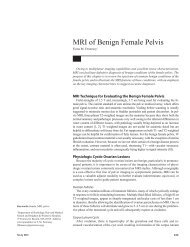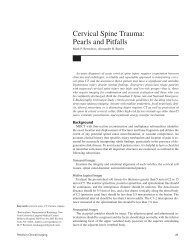Scientific Session 1 â Breast Imaging: Mammography
Scientific Session 1 â Breast Imaging: Mammography
Scientific Session 1 â Breast Imaging: Mammography
You also want an ePaper? Increase the reach of your titles
YUMPU automatically turns print PDFs into web optimized ePapers that Google loves.
<strong>Scientific</strong> <strong>Session</strong> 8—Musculoskeletal <strong>Imaging</strong>: Lower ExtremityTuesday065. Posterior Impingement at the Ankle: Depiction and ClinicalCorrelation in Professional Ballet Dancers on Plantarflexed MRIColucci, P. 1 *; Morrison, W. 1 ; Zoga, A. 1 ; Green, J. 2 ; Chao, W. 3 1. ThomasJefferson University Hospital, Philadelphia, PA; 2. Pennsylvania Ballet,Philadelphia, PA; 3. Pennsylvania Hospital, Philadelphia, PAAddress correspondence to W. Morrison (william.morrison@jefferson.edu)Objective: Posterior impingement at the ankle is a common source ofposterior pain on plantarflexion in the general population, especiallyamong athletes or individuals with an os trigonum. We sought to evaluatefindings associated with pain using MRI in plantarflexion in a populationof ballet dancers, who have a very high incidence of the condition.Materials and Methods: Ankles of 12 professional ballet dancers werescanned at 1.5 T in plantarflexed position. Images were evaluated for presenceof an os trigonum, cartilage loss or osteochondal lesions, bone proliferation,joint effusion or synovitis, ganglion cysts, and tenosynovitis. Correlationwas made with physical examination and an orthopedic ankle questionnaire.Results: Ten female and two male ballet dancers were imaged. Six reportedactive pain or tenderness at the posterior ankle. Plantarflexed MRIwas able to show the abutment of the tibia and talus in all cases. Therewere no ossicles. However, one individual had a bipartite talus. No individualshad significant joint effusion or synovial proliferation. Two hada ganglion cyst; both reported active pain and tenderness. Seven (all female)had osteochondral lesions and bone proliferation at the posteriortalus; three had corresponding cartilage loss at the posterior tibia. Sixof seven reported symptoms at some point in their career, and four hadcurrent pain. One had flexor hallucis longus tenosynovitis and reportednonpainful posterior snapping. One male dancer had Achilles tendinosiswith active posterior pain but had no signs associated with impingement.Conclusion: A variety of abnormalities can be seen on MRI in posteriorankle impingement, including ganglion cysts and posterior ankle joint osteochondrallesions. Plantarflexed MRI was able to show the abutment ofthe tibia and talus in all cases and may be useful in evaluation of patientswith clinical posterior impingement.066. MRI of the Ankle With and Without Simulated Weight-Bearing: Technique and Feasibility for Diagnosis of Posterior TibialTendon DysfunctionDonoso, G.*; Morrison, W.; Long, S.; Zoga, A.; Shortt, C. ThomasJefferson University Hospital, Philadelphia, PAAddress correspondence to W. Morrison (william.morrison@jefferson.edu)Objective: Although MRI is useful for evaluation of the morphology ofthe posterior tibial tendon (PTT) and spring ligament complex, dysfunctionis diagnosed clinically based on evaluation of the arch during stress.Our goal was to develop and test a method for applying similar stress ina standard whole-body MR environment.Materials and Methods: Using a commercially available device that appliesaxial load in the supine position, 21 patients with concern for PTTdysfunction were scanned with one half weight-bearing stress using a standardwhole-body 1.5-T system. Because the loading platform precludesuse of the extremity coil, a surface coil was used. A routine examinationwas performed without stress, followed by sagittal and axial imaging withstress. The arch angle was measured before and after stress, and correlationwas performed with morphology of the PTT and spring ligament.Results: Twenty-one patients (15 female, six male; age range, 14–74 years;mean age, 48 years) were included. PTT was normal in nine and abnormalin 12 (tendinosis, eight; tear, four). Spring ligament was normal in 13 andabnormal in eight (thickened, six; thinned, one; edematous, five). Change inthe arch measurement pre- and poststress was 5.1º over the entire population.For normal PTT/normal spring (n = 7), the prestress range was 2–18º (mean,8.4º), the poststress range was 5–15º (mean, 9.6), and the change was –3º to4º (mean ± SD, 0.71º ± 2.3º). For abnormal PTT/abnormal spring (n = 6), theprestress range was –2º to 24º (mean, 13.2), the poststress range was 13–30º(mean: 23º), and the change was 2–19º (mean ± SD, 10.33º ± 6.4º). For abnormalPTT/normal spring (n = 6), the prestress range was 2–20º (mean,11.2º), the poststress range was 7–27º (mean: 17.5º), and the change was1–12º (mean ± SD, 6.33º ± 4.9º). For normal PTT/abnormal spring (n = 2),the prestress range was 5–16º (mean: 10.5º), the poststress range was 6–18º(mean, 12º), and the change was 1–2º (mean ± SD, 1.5º ± 0.7º). There was asignificant difference between the subgroups (analysis of variance, p = 0.01).Conclusion: Simulated weight-bearing of the ankle is feasible in a closed,whole-body 1.5-T MR system. There is a measurable difference in angulationof the medial longitudinal arch before and after stress. Thesechanges appear to reflect pathology of the PTT and spring ligament andmay be useful for staging patients with PTT dysfunction.067. Acute Lateral Patellar Dislocation: Incidence and Patternsof Osseous, Cartilaginous, and Medial Patellofemoral LigamentInjury in 150 Patients on MRIMenon, S. 1 *; Rapaport, H. 1 ; Khalaf Al-Tawil, O. 1 ; Scuderi, G. 1 ; Katz,D. 2 ; Math, K. 1 1. Beth Israel Medical Center, New York, NY; 2.Winthrop-University Hospital, Mineola, NYAddress correspondence to D. Katz (dkatz@winthrop.org)Objective: To review the spectrum of MRI findings seen in 150 consecutivepatients with acute lateral patellar dislocation and to present the incidence ofpatellar and lateral condyle injuries, patterns of medial patellofemoral ligamentinjury, and prevalence of associated findings including cartilage injury,medial collateral ligament (MCL) injury, meniscal tear, and loose bodies.Materials and Methods: One hundred fifty consecutive knee MRI examinationsin patients with acute lateral patellar dislocation were identifiedretrospectively at one tertiary-care teaching hospital. MR examinationswere performed on a 1.5-T magnet, using a standard unenhanced protocol.The MR examinations were reviewed in consensus by two musculoskeletalradiologists and one radiology resident for the incidence and locationof medial patellofemoral ligament (MPFL) injury, lateral femoralcondyle and patellar injury, meniscal tear, MCL injury, and loose body.Results: Seventy-seven patients (51%) were female, and 73 patients (49%)were male, with a mean age of 28 years (range, 10–72 years). One hundredtwenty-four had MR evidence of bony injury to the medial patella (83%),with 115 bone contusions (77%) and nine fractures (6%). There were 89(59%) with patellar chondral injuries, and of these 71 were medial patellarfacet (80%), and 18 patellar apex (20%). One hundred forty-three (95%)had contusion at the anterolateral aspect of the lateral femoral condyle, associatedwith contour deformity of the condyle in 42 (28%). Twenty-fivehad chondral injury of the lateral femoral condyle (17%). One hundredthirty-seven had injury of the MPFL (91%). Of these MPFL injuries, 60(44%) primarily involved the femoral attachment, 31 (23%) favored thepatellar attachment, and 46 had a diffuse pattern of injury (34%). Intra-A26*Will present paper
















